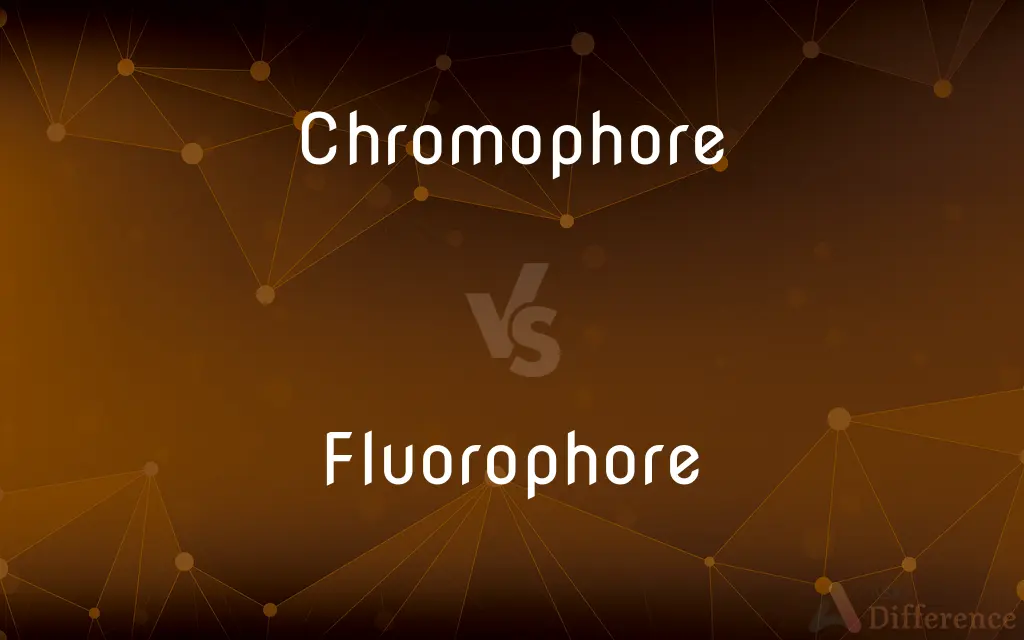Chromophore vs. Fluorophore — What's the Difference?
By Urooj Arif & Fiza Rafique — Updated on March 21, 2024
Chromophores absorb light at specific wavelengths, imparting color, while fluorophores not only absorb but also emit light at a different wavelength.

Difference Between Chromophore and Fluorophore
Table of Contents
ADVERTISEMENT
Key Differences
Chromophores are molecular fragments that absorb visible or ultraviolet light, causing substances to have color or appear colored under certain conditions. They play a crucial role in the coloration of materials and biological compounds. On the other hand, fluorophores are a type of chromophore that not only absorb light but also re-emit it at a longer wavelength, a phenomenon known as fluorescence. This ability makes them invaluable in scientific research, particularly in fluorescence microscopy and molecular tagging.
The absorption of light by chromophores results in a specific color appearance due to the selective absorption and reflection of certain wavelengths. For instance, the color we see in dyes and pigments is due to the presence of chromophores within these substances. Whereas fluorophores, upon absorbing light, enter an excited state and then return to their ground state by emitting light, often visible as a bright glow under specific lighting conditions, thereby providing a powerful tool for visualizing and tracking biological molecules and processes.
Chromophores are integral to the function of a wide range of substances, from natural pigments in plants and animals to synthetic dyes used in the textile industry. They determine the colors of these substances by the wavelengths of light they absorb. Fluorophores, while also impacting color through absorption, are more renowned for their emission properties, enabling them to illuminate specific targets in complex biological environments, making them essential for labeling and imaging applications in biotechnology and medical diagnostics.
In terms of applications, chromophores are extensively used in the development of dyes and pigments for textiles, paints, and inks. Their ability to absorb certain wavelengths of light and reflect others is what imparts color to these materials. Fluorophores find their use predominantly in the scientific and medical fields, where their fluorescence capabilities are utilized in assays, microscopy, and in the study of cellular and molecular dynamics.
The study and application of chromophores and fluorophores underscore the intersection of chemistry, physics, and biology. Chromophores help us understand the fundamental aspects of light absorption and color perception. In contrast, fluorophores extend this understanding by adding the dimension of light emission, providing insights into the energetic transitions within molecules and their interactions within biological systems.
ADVERTISEMENT
Comparison Chart
Light Interaction
Absorb specific wavelengths of light
Absorb and re-emit light at different wavelengths
Result
Impart color by selective light absorption
Emit light, causing fluorescence
Applications
Dyes, pigments, coloration in biology
Fluorescence microscopy, molecular tagging, diagnostics
Primary Function
Coloration
Visualization and tracking
Scientific Importance
Understanding of light absorption and color perception
Used in studying biological processes and structures
Compare with Definitions
Chromophore
A molecule or part of a molecule that absorbs light at a specific wavelength, causing substances to appear colored.
The chromophore within the pigment chlorophyll absorbs red and blue light, making plants appear green.
Fluorophore
A chromophore with the special ability to fluoresce, emitting light upon excitation.
This fluorophore is particularly useful due to its high quantum yield and stability under light exposure.
Chromophore
The cause of visible colors in compounds due to selective light absorption.
The vibrant colors in bird feathers are often due to chromophores that absorb specific wavelengths of light.
Fluorophore
A component of molecules used in fluorescence imaging and assays.
Fluorophores are critical in tagging and tracking cellular components in live-cell imaging.
Chromophore
A component that imparts color to a compound.
In the compound, the presence of a chromophore is essential for its application as a dye.
Fluorophore
A substance used for its properties of fluorescence in various scientific applications.
The experiment utilized a specific fluorophore to study the dynamic processes within the cell nucleus.
Chromophore
Molecular fragments that can cause a substance to change color under various conditions.
The chromophore in pH indicators changes color depending on the acidity of the solution.
Fluorophore
A molecule that absorbs light at one wavelength and emits it at another, typically longer, wavelength.
The fluorophore attached to the antibody made it possible to visualize the cells under a fluorescence microscope.
Chromophore
The part of a molecule responsible for its color.
The chromophore groups in synthetic dyes determine the colors of fabrics.
Fluorophore
A molecular marker that emits light upon excitation, used in biological and chemical research.
The selection of fluorophores with different emission spectra enabled the simultaneous study of multiple targets in the sample.
Chromophore
A chromophore is the part of a molecule responsible for its color. The color that is seen by our eyes is the one not absorbed by the reflecting object within a certain wavelength spectrum of visible light.
Fluorophore
A fluorophore (or fluorochrome, similarly to a chromophore) is a fluorescent chemical compound that can re-emit light upon light excitation. Fluorophores typically contain several combined aromatic groups, or planar or cyclic molecules with several π bonds.Fluorophores are sometimes used alone, as a tracer in fluids, as a dye for staining of certain structures, as a substrate of enzymes, or as a probe or indicator (when its fluorescence is affected by environmental aspects such as polarity or ions).
Chromophore
Any of various chemical groups that absorb light of certain wavelengths and when present in an organic compound, such as a dye or pigment, are responsible for the color of the compound.
Fluorophore
Any group of atoms whose presence in a molecule causes the molecule to be fluorescent.
Chromophore
(chemistry) that part of the molecule of a dye responsible for its colour
Fluorophore
Any fluorescent compound.
Chromophore
(chemistry) (more generally) the group of atoms in a molecule in which the electronic transition responsible for a given spectral band is located
Fluorophore
A fluorochrome that is conjugated with a protein or other macromolecule and used as a probe or assay.
Chromophore
Any chemical group or residue (as NO2; N2; or O2) which imparts some decided color to the compound of which it is an ingredient.
Fluorophore
Any of various chemical groups or structural domains that are responsible for the fluorescent properties of a substance.
Chromophore
The chemical group that gives color to a molecule
Fluorophore
(biochemistry) A molecule or functional group which is capable of fluorescence.
Common Curiosities
Where are fluorophores commonly used?
Fluorophores are utilized in scientific research for fluorescence microscopy, molecular tagging, and diagnostics.
What is a fluorophore?
A fluorophore is a type of chromophore that absorbs light at one wavelength and re-emits it at another, causing fluorescence.
Why are fluorophores important in microscopy?
Fluorophores enable the visualization and tracking of specific components within cells and tissues, enhancing the detail and specificity of microscopic images.
What is a chromophore?
A chromophore is a molecule or part of a molecule that absorbs specific wavelengths of light, resulting in coloration.
How do chromophores affect the color of a substance?
Chromophores absorb certain wavelengths of light, and the reflected or transmitted light determines the substance's color.
What factors affect the color emitted by a fluorophore?
The chemical structure of the fluorophore, the environment it's in, and the wavelength of the exciting light all influence
What are the applications of chromophores?
Chromophores are used in dyes, pigments, and understanding coloration in natural and synthetic substances.
Can a molecule contain both chromophores and fluorophores?
Yes, a molecule can contain both; fluorophores are essentially chromophores with the additional ability to emit light.
How do chromophores and fluorophores differ in their interaction with light?
Chromophores absorb light to impart color, while fluorophores absorb and then re-emit light at a longer wavelength.
Do all chromophores fluoresce?
No, not all chromophores fluoresce. Fluorescence is a specific property of fluorophores.
What makes a fluorophore useful in biological assays?
Its ability to bind specifically to other molecules and fluoresce under light excitation makes it invaluable for identifying and tracking biological processes.
How is fluorescence from a fluorophore detected?
Fluorescence is detected using instruments like fluorescence microscopes or spectrophotometers, which can measure the specific wavelengths of light emitted.
Share Your Discovery

Previous Comparison
Lithe vs. Flexible
Next Comparison
Notebook vs. BinderAuthor Spotlight
Written by
Urooj ArifUrooj is a skilled content writer at Ask Difference, known for her exceptional ability to simplify complex topics into engaging and informative content. With a passion for research and a flair for clear, concise writing, she consistently delivers articles that resonate with our diverse audience.
Co-written by
Fiza RafiqueFiza Rafique is a skilled content writer at AskDifference.com, where she meticulously refines and enhances written pieces. Drawing from her vast editorial expertise, Fiza ensures clarity, accuracy, and precision in every article. Passionate about language, she continually seeks to elevate the quality of content for readers worldwide.














































